
James F. Steranko is an American graphic artist, comic book writer/artist, comics historian, magician, publisher and film production illustrator.

An American comic book is a thin periodical originating in the United States, on average 32 pages, containing comics. While the form originated in 1933, American comic books first gained popularity after the 1938 publication of Action Comics, which included the debut of the superhero Superman. This was followed by a superhero boom that lasted until the end of World War II. After the war, while superheroes were marginalized, the comic book industry rapidly expanded and genres such as horror, crime, science fiction and romance became popular. The 1950s saw a gradual decline, due to a shift away from print media in the wake of television and the impact of the Comics Code Authority. The late 1950s and the 1960s saw a superhero revival and superheroes remained the dominant character archetype throughout the late 20th century into the 21st century.
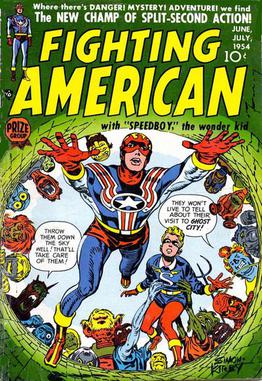
Fighting American is a superhero created in 1954 by the writer-artist team of Joe Simon and Jack Kirby. Published by the Crestwood Publications imprint Prize Comics, it was, contrary to standard industry practices of the time, creator-owned. Harvey Comics published one additional issue in 1966. One final inventoried tale was published in 1989, in a Marvel Comics hardcover collection of all the Fighting American stories.

Dark Circle Comics is an imprint of Archie Comics Publications, Inc. Under its previous name, Red Circle Comics, it published non-humor characters, particularly superheroes in the 1970s and 1980s.

The Shield is the name of several superheroes created by MLJ. Appearing months before Captain America, the Shield has the distinction of being the first superhero with a costume based upon United States patriotic iconography. The character appeared in Pep Comics from issue #1 to #65.

Boy Commandos is a fictional organization from DC Comics first appearing in Detective Comics #64 by Joe Simon and Jack Kirby. They are a combination of "kid gang" characters, an international cast of young boys fighting Nazis — or in their own parlance, "the Ratzies".
Morton Meskin was an American comic book artist best known for his work in the 1940s Golden Age of Comic Books, well into the late-1950s and 1960s Silver Age.
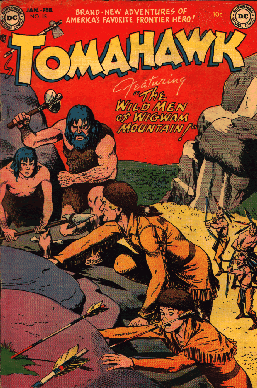
Tomahawk is an American comic book character whose adventures were published by DC Comics during the 1940s, 1950s and 1960s as a backup feature in Star Spangled Comics and World's Finest Comics and in his own eponymous series. He was created by writer Joe Samachson and artist Edmond Good, and first appeared in Star-Spangled Comics #69. Tomahawk's uniqueness stems in part from the time frame of his adventures: the American Revolutionary War.
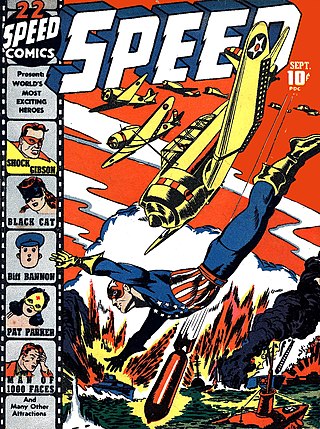
Captain Freedom is a superhero from the period known as "Golden Age of Comic Books". His creator was identified as "Franklin Flagg" in the credits, but the identity of the individual behind the pseudonym remains unknown. He first appeared in Speed Comics #13, a Harvey Comics title. He continued to appear in Speed Comics until its cancellation in #44.

Crestwood Publications, also known as Feature Publications, was a magazine publisher that also published comic books from the 1940s through the 1960s. Its title Prize Comics contained what is considered the first ongoing horror comic-book feature, Dick Briefer's "Frankenstein". Crestwood is best known for its Prize Group imprint, published in the late 1940s to mid-1950s through packagers Joe Simon and Jack Kirby, who created such historically prominent titles as the horror comic Black Magic, the creator-owned superhero satire Fighting American, and the first romance comic title, Young Romance.

Captain Flag is a superhero created by MLJ Comics' writer Joe Blair and artist Lin Streeter. He first appeared in September 1941, in issue #16 of Blue Ribbon Comics. He continued until the last issue, Blue Ribbon Comics #22.
Harvey Thriller was a comic book imprint used by Harvey Comics for their brief foray into publishing super heroes and other non-'kiddie' comics in the mid-1960s. Overseen by Joe Simon, all the titles featured work by many well-known creators, including Jack Kirby, Bob Powell, Wally Wood, Otto Binder, and the earliest known work by Jim Steranko.

Captain 3-D is a superhero appearing in comic books published by Harvey Comics. Created by Joe Simon and Jack Kirby, the character marked an early attempt to produce a 3-D comic book.
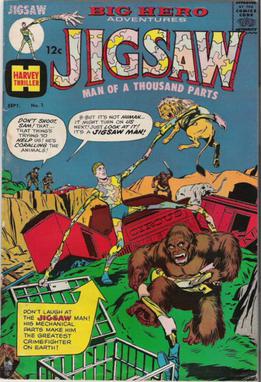
Jigsaw is a Joe Simon-created character and two-issue comic series published by Harvey Comics from September to December 1966.

Magazine Enterprises was an American comic book company lasting from 1943 to 1958, which published primarily Western, humor, crime, adventure, and children's comics, with virtually no superheroes. It was founded by Vin Sullivan, an editor at Columbia Comics and before that the editor at National Allied Publications, the future DC Comics.

The Woman in Red is a fictional character that first appeared in the period known to comic book historians as the Golden Age of Comic Books. Created by writer Richard E. Hughes and artist George Mandel, she first appeared in Thrilling Comics #2, published by Nedor Comics. The character was later revived by writer Alan Moore for America's Best Comics. She would also be used by Dynamite Entertainment in Project Superpowers Chapter Two.

The Black Owl is the name of two fictional superhero characters. Both appeared in the Prize Publications title Prize Comics in the 1940s.
Francis Edward Herron was an American comic book writer and editor active in the 1940s–1960s, mainly for DC Comics. He is credited with co-creating Captain Marvel Jr. and the Red Skull, as well as such characters as Cave Carson, Nighthawk, and Mr. Scarlet and Pinky the Whiz Kid. Herron spent the bulk of his time in the comics industry writing for such characters as Green Arrow, Superman, and the Western character Tomahawk.
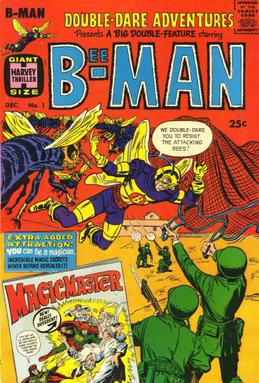
Bee-Man is a fictional supervillain turned superhero in comic books published by Harvey Comics, who briefly appeared during the period historians and fans call the Silver Age of Comic Books. He was created by artist/writer/editor Joe Simon, writer Otto Binder and artist Bill Draut.
















